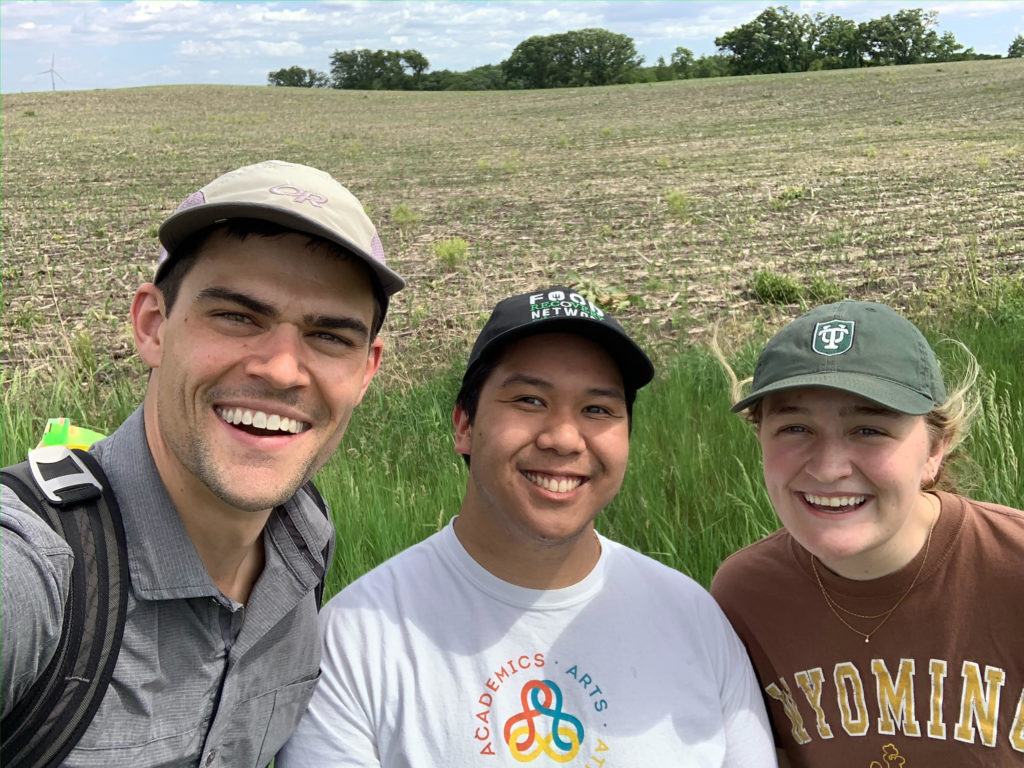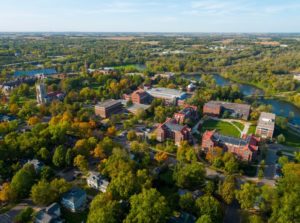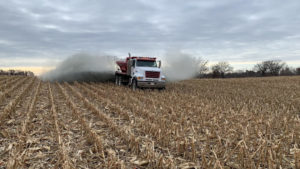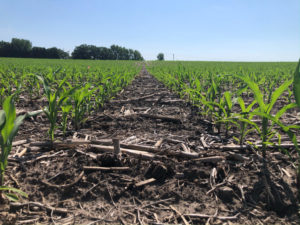Study Captures Data to Turn Midwestern Farms into Carbon Sinks
(Left to right) Prof. Daniel Maxbauer, Jaren Yambing, and Ella Milliken
Carleton College geologists join a growing wave of research into the carbon-trapping power of pulverized rock in America’s agricultural fields
No one could have predicted the severe heatwave that would swelter Ella Milliken and Jaren Yambing’s first week of baseline field testing in June 2021—except maybe climate scientists. It was the longest heatwave to occur so early in a Minnesotan summer.
Under a blazing June sun, the Carleton College research assistants walked among rows of knee-high corn saplings in 90-degree weather. Flagging the corners of 12 half-acre plots, they then set up each flag with a GPS system to later take samples with soil cores. At the end of each six-hour-long day, they collapsed in a dazed nap. Tired as they were, they were also excited to take part in a study that is novel to the Midwest.
“This is one of the only silicate weathering studies out there,” says Milliken. One that can shed light on how the Midwest’s farmlands can trap carbon to help quell future climatic events, like a heatwave.
The growing evidence that enhanced silicate weathering can be an effective agricultural carbon-sequestering method inspired Daniel Maxbauer (the geologist who is leading the study) to create the field trial. That, and a sudden lack of mobility caused by a global pandemic.
Back in March 2020, Maxbauer’s geological fieldwork crumbled in the life-altering freeze of early quarantine. Like so many did during a time of stay-at-home orders, Maxbauer turned his attention to projects of proximity—but instead of reaching for sourdough starter, he began researching how to create a 3-year trial study on campus.
There’s this mid-continent rift that happened a couple of million years ago that pulled apart and spit out basalt silicates. It’s so cool that we have such old material that can help us now in our climate situation.”Jaren Yambing
“I figured they couldn’t prevent me from walking outside to a field to do some work,” says Maxbauer. The study merges geology and regenerative agriculture not only to enrich soil health but also to sequester atmospheric carbon, which if left unchecked is predicted to bring global warming to 3°C above pre-industrial levels by 2100.
The idea for the trial emerged while teaching climate-conscious Carleton University graduate students about enhanced silicate weathering and studying the linkages between soil and magnetic mineral formation in agricultural fields in southeastern Minnesota. Through that project, he realized that he was smack in the middle of a farming community interested in carbon-trapping regenerative agricultural practices, like photosynthesis-extending cover crops and rock dust application. This surprised him. The idea of spreading crushed rocks to make crops grow seemed strange to him.
“But it didn’t seem weird to farmers,” Maxbauer says. “They are already spreading crushed rocks on their fields.” Maxbauer saw an opportunity to tap into the enthusiasm expressed by other climate-conscious geology scholars and the local agricultural community to become part of a wave of research that is pulling geology into the future.
break
Bridging the worlds of geology and regenerative agriculture
Since the 20th century, paleoclimatologists have studied climates of the past by analyzing rocks that turn carbon into stone over long periods of time via weathering. These scientists work to understand chemical interactions that depend on an interplay of atmospheric and geologic processes.
The chemistry is complicated, but it works like this: rocks are held together by a bank of minerals. When carbon dioxide dissolved in rain lands on minerals known as calcium silicates, it triggers what’s called the Urey Reaction: a process that combines atmospheric CO2 with calcium silicates to generate calcium carbonates. Ultimately, the carbon becomes trapped in mineral masses and locked underground. On geologic timescales, this process can take 100,000 to 200,000 years.
Agrarian societies from around the world have understood how to speed up weathering to tap into mineral banks for farming since the ancient past. It’s why so many communities can be found living near active volcanoes: as it turns out, being neighbors with a terrifying geologic feature pays off. Cooled magma creates basalt-rich material that breaks down a lot easier than other kinds of rocks, making its nutrients readily accessible to plants by speeding up the weathering process to a handful of years. Farmers in Southeast Asia, like in Indonesia for example, use basalt sourced locally from volcanic fields to bolster rice paddies and cocoa plants.
“The people applying crushed silicate rocks weren’t the same people studying silicate rocks weathering” until these two spheres intersected in the mid-2000s, according to Maxbauer. That’s because bringing these worlds together isn’t easy. It requires a team effort between agriculturalists, mining companies, scientists, and government institutions. A balance that has been struck in Brazil, which stands as an epicenter of research on agrogeology and soil remineralization (as seen in a 2021 paper by Manning and Theodoro).
Getting America’s agricultural system to incorporate it is feasible due to an infrastructure that was made to handle rock dust. Rock quarries exist pretty much everywhere and farmers already have the technology to use the input.
“In agricultural systems…the fact that the infrastructure already exists, like I’m a farmer and I have a specialized tractor that can spread rock dust. It makes it a very attractive way for people to co-opt an existing technology,” Yambing says.
break
Capturing carbon with basalt
Scientists already know that basalt can capture a significant amount of carbon dioxide. If half of the world’s farmland treated their soil with basalts, it could capture two billion tons of CO2 per year, according to a recent analysis published by the journal Nature. To keep temperature rise within 1.5°C, as outlined in the Paris Agreement, the United States would need to reach net-zero by removing about 2 gigatons of CO2 per year by midcentury, according to a paper published by the World Resources Institute.
“In agricultural systems…the fact that the infrastructure already exists, like I’m a farmer and I have a specialized tractor that can spread rock dust. It makes it a very attractive way for people to co-opt an existing technology.”Jaren Yambing
The biggest hurdle for enhanced silicate weathering is a lack of wide-scale analysis of how basalt treatment can work across different kinds of environments on a grand scale. A trove of data about complex interactions between soil, minerals, and CO2 can ensure farmers are applying the right kind of materials for their plots; the list of things scientists need to evaluate to get a full picture is long: soil type, plant species, rock, mineral type, rock particle size, application amount, study duration, and modifications with compost or silicate dissolving bacteria all have to be accounted for. Getting all this information is key to making sure the system works.
Gauging silicate quality ensures that there aren’t heavy metals being applied to soil. “It’s pretty important to farmers,” says Milliken. “One of the biggest critiques is that when you’re spreading rock you can get bad minerals in the soil.” Geologists use a process called X-ray diffraction in order to find the mineral makeup of rock formations by blasting rock with x-rays. A lab at Carleton University used the method to ensure the makeup of the rocks they used were safe for the study.
Large trials have just begun to be conducted in the United States, the first one being done on the West and East Coasts by a team led by Benjamin Z. Houlton. Given how emergent these studies are in the U.S., Maxbauer would have to create a playbook from scratch. He expected to meet some friction when asking around to see if any agriculturalists would take him up on the project. But as soon as he floated the idea to the folks at Peterson Farms who have a lease on the college land, “they were like, ‘yeah sure, do you want to do it now?’ And, I was like, ‘no, I don’t even know what I’m doing!’”
break
Creating a playbook for enhanced silicate weathering from Scratch
Running a field trial isn’t like running a study in a controlled lab where materials are well contained and accounted for. Capturing something as elusive as carbon dioxide and groundwater in the environment is hard enough as it is. “You’re trying to track the products of minerals dissolving and flowing away in groundwater into the watershed,” Maxbauer explains. Along with capturing data in a real-life environment, he also needed to know practical details, such as how much room tractors need to go up and down each plot without running over precious living data.
After speaking to Houlton’s team about the way they set up their silicate weathering trial, parameters for the study began to take shape. Since locality is key to creating a realistic blueprint for how rock dust could be used in the Midwest, rock dust was sourced from Dresser Trap Rock Inc., a Wisconsin quarry that lies 80 miles away from Carleton University.
The quarry holds trap rock, a type of volcanic basalt. Known as North America’s hardest rock, it has been used to test drills employed on moon probes. NASA scientists and geologists have the chaotic splitting of Earth’s crust to thank for access to this important resource.
“There’s this mid-continent rift that happened a couple of million years ago that pulled apart and spit out basalt silicates,” Yambing mused. “It’s so cool that we have such old material that can help us now in our climate situation.”
Milliken and Yambing, enamored by the prospect of helping their local community by using geologically historic materials, were the first to get their hands in the dirt as soon as their finals were over. They later enlisted the help of other research students for early sampling and soil analysis.
For each 12-acre plot, farmers bolstered soil health by using a no-till method and applied nitrogen, potassium, and phosphorus fertilizers—a standard in conventional agriculture. At the end of the growing season, a cover crop was incorporated. By November, the fields received their first application of rock dust.
As the crushed powders interacted with the microorganisms and plant matter from the first crop of corn, Milliken and Yambing set out to create a rock dust study of their own making in a greenhouse on campus.
“We were growing these corn in huge PVC tubes and half of them we added some of our silicate dust, and half we didn’t,” Yambing explains.
They used the field study as a guide, measuring soil and water properties over the course of four months to see if plants were absorbing the minerals from the rock dust. Their patience was tested in the greenhouse environment they created. They soaked tubes for hours, had a giant column explode layers of carefully packed soil onto the floor, and manually untangled root systems from the pipes, piece by piece, to weigh biomass. It taught them what works and doesn’t work in an experimental design, a valuable skill they will apply once they move on from Carleton.
Milliken admits that it was stressful, but with support from university staff, they were able to get the satisfaction of preliminary results by analyzing soluble CO2, or bicarbonates, from their pipe plots.
“All the water that came out of the plants, when we add up all the bicarbonate, there’s a little bit more bicarbonate in the pots that had the silicates versus the ones that didn’t. So that’s a sign to us that there’s some carbon sequestration going on,” Yambing explains.
These findings gave them a preview of what could come out of the 3-year field study that they will only be able to work on for another season. Since they graduate in June, their next task will be to prepare the next group of research assistants who will help Maxbauer install lysimeters—a kind of giant straw that sucks up groundwater to look at how rock dust impacts the soil—and soil collars, which will measure CO2 and nitrous oxide by reading gasses emitted by the soil.
Over the next 2 years, research assistants will use these methods to measure soil water year over year from alternating crops of soy and corn, so that at the end of the study, researchers can see how well treated plots were able to sequester carbon and make use of nutrients after being treated.
break
The ‘Pie in the Sky’ Potential of Rock Dust
It’s not enough for researchers to find out that carbon is being sequestered, they need to know how well plants can grow and at what rate their soils can sequester carbon. If scientists can prove the efficacy of regenerative practices on a grand scale, governments, and large agricultural companies will be more likely to incorporate these practices into a carbon-credit system using existing resources and infrastructure.
Maxbauer saw an opportunity to tap into the enthusiasm expressed by other climate-conscious geology scholars and the local agricultural community to become part of a wave of research that is pulling geology into the future.Shenise Ramirez
Rather than spend millions of dollars on air capture technology that requires a quarter of the world’s energy supplies—only to put away a paltry 1.5 gigatons of carbon per year according to a study by Nature—it would be easier to pay farmers using regenerative agriculture for the carbon removal their work already does. The Biden administration is in the process of getting approval for a bill that would use $4M to pay farmers to do just that.
In 2021, the Senate passed the Growing Climate Solutions Act, a bill that streamlines agricultural carbon credit systems to verify the amount of carbon farmers and ranchers sequester with sustainable agricultural practices. Enhanced silicate weathering could easily be incorporated into carbon credit systems.
“[Enhanced silicate weathering] would be an easy method to quantify the amount of carbon that is being sequestered. It can be widely applicable to a lot of different systems and give back to communities who are already sequestering carbon and get a monetary benefit from doing that,” says Milliken, who dreams of rock dust being sprinkled across many systems all over the world. “Carleton has a large arboretum, or spread it in large boreal forest systems; you could expand it in conservation and restoration.” For Milliken, the possibilities are endless.
As the United States begins to eye ways to reach net-zero carbon emissions, interest in carbon capture has seen an uptick. Milliken hopes to ride the wave and become part of the next cohort of researchers that will make carbon capture an important tool to tackling climate change in the future.”I’m really interested in applying a lot of climate solutions that are being researched right now, such as silicate weathering, on a wider scale.” Milliken says. “It is the sort of research that gives me hope and makes me feel like I’m creating a better future.”
But in order for this to become reality, we need to make sure to get the right kinds of silicate to the right regions. Success comes when you find the right rock dust for the specific soil.
“Soils are very different all over the country and all over the world, the materials that can be used in any one region depend on how close you are to sources of these silicate materials. If in one region there is a material that seems to work well, that doesn’t mean that it’s going to work across all of the United States or all of North America,” says Maxbauer.
To create the perfect microbial environment for carbon sequestration, land stewards will have to play matchmaker with soils and silicates. Their success will rely heavily on research. “This is going to take a lot of people studying a lot of different materials in a lot of different areas in order to reach a scale that hits these ‘pie in the sky’ goals.”
break
Shenise Ramirez is a multimedia journalist, environmental sci-fi writer, and educator with a soft spot for agroecology. They have backpacked from newsrooms to mountains for the past seven years, producing content for platforms like iHeartRadio, FiOS1 News, Business Insider, and UrbanOne. As a science writer and social media editor for RTE, they use multimedia storytelling to translate research into stories that bring readers behind the scenes of groundbreaking science. They believe intersectional journalism creates fertile ground for past transgressions to grow into an environmentally just future.
Support us on Patreon
Thank you for joining us today! Please become a member of RTE and support us on Patreon. Unlike many larger organizations, we work with a team of determined and passionate volunteers to get our message out. We aim to continue to increase the awareness of remineralization to initiate projects across the globe that remineralize soils, grow nutrient dense food, regenerate our forests’ and stabilize the climate – with your help! If you can, please support us on a monthly basis from just $2, rest assured that you are making a big impact every single month in support of our mission. Thank you!











JEAN ALEXIS SOULE
May 18, 2022 (4:20 pm)
Interesting article. No definition of ESW
Joanna Campe
June 5, 2022 (11:54 am)
Thank you for pointing this out! We have updated the article to replace ‘ESW’ with ‘enhanced silicate weathering.’ This is more commonly referred to as ‘ERW’ or ‘enhanced rock weathering.’